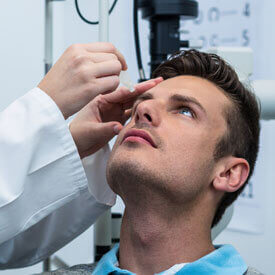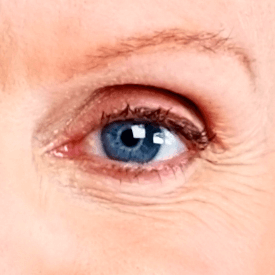- Procedure Name:
- Eye Exams Service
Comprehensive eye exams go beyond a typical vision test to evaluate the overall health of your eyes, including any existing or potential eye disease.
- Procedure Name:
- Myopia (Nearsightedness) Service
Myopia (nearsightedness) is an eye condition in which the eye shape is elongated, causing light to hit the retina improperly and blurring far vision.
- Procedure Name:
- Hyperopia (Farsightedness) Service
Hyperopia (farsightedness) is an eye condition in which the eye is shortened, causing light to hit the retina improperly and blurring near vision.
- Procedure Name:
- Presbyopia (Vision Loss 40+) Service
Presbyopia is a type of vision impairment that begins around the age of 40 due to the natural thickening and loss of flexibility of the eye's lens.
- Procedure Name:
- Common Eye Infections Service
Common eye infections, including styes, pink eye, and blepharitis, can be mild or severe and are usually caused by viruses, bacteria, or fungi.
- Procedure Name:
- Eyelid Conditions Service
Styes and chalazions are very common eyelid inflammations that may go away on their own or can be drained or excised if necessary due to irritation.
- Procedure Name:
- Dry Eye Syndrome Service
Dry eye syndrome is the eyes' inability to produce sufficient or good-quality tears, leading to pain, itching, redness, grittiness, and blurry vision.
- Procedure Name:
- Eye Allergies Service
Eye allergies are very common, and the symptoms can range from mild to severe and include itching, watering, red eyes and swollen, itching eyelids.
- Procedure Name:
- Uveitis Service
Uveitis occurs when the uvea (middle part of the eye wall) becomes inflamed, usually due to underlying autoimmune disease, injury, or infection.
- Procedure Name:
- Refractive Surgery Explained Service
Refractive surgeries are done to correct refractive errors, like myopia, hyperopia, and astigmatism, and include LASIK, LASEK, PRK, RLE, CK, and ICL.
- Procedure Name:
- LASIK Service
LASIK is a fast, effective, and safe method of vision correction that works by changing the shape of the cornea via advanced laser technology.
- Procedure Name:
- PRK Service
Photorefractive keratectomy (PRK) involves the removal of the epithelium, which can grow back in days, to access and reshape the cornea beneath.
- Procedure Name:
- Refractive Lens Exchange Service
For patients not eligible for laser vision correction, RLE replaces the natural lens of the eye with an artificial lens to correct refractive errors.
- Procedure Name:
- EVO Visian ICL Service
EVO Visian ICL is made for people who want to experience life without the hassle of glasses or contact lenses.
- Procedure Name:
- Cataracts Explained Service
Cataracts develop as the proteins in the lens of the eye start to degrade, which happens to everyone with age and due to other environmental factors.
- Procedure Name:
- Apthera™ Service
The Apthera™ IOL is a replacement lens exclusively designed to give you clear, focused vision from near to far, and everything in between.
- Procedure Name:
- Traditional Cataract Surgery Service
In micro-incision cataract surgery, an extremely fine diamond blade creates the incision through which the natural lens is removed and replaced.
- Procedure Name:
- Laser Cataract Surgery Service
Laser cataract surgery utilizes cutting-edge technology to place and make the tiny, precise incision necessary for removing and replacing the lens.
- Procedure Name:
- Cataract Lens Options Service
Intraocular lenses are artificial lenses used in cataract removal surgery to replace the cataract and restore or even improve the patient's vision.
- Procedure Name:
- Light Adjustable Lens™ Service
The Light Adjustable Lens is an alternative option to IOLs during cataract surgery in order to achieve customizable, clearer vision results.
- Procedure Name:
- Cornea Diseases and Disorders Service
Corneal damage stemming from disease, infection, or injury can lead to vision loss; however, there are many safe and effective treatments available.
- Procedure Name:
- Keratoconus Service
Keratoconus, a progressive disease of the cornea, can lead to vision loss or blindness as it gradually thins and changes the shape of the cornea.
- Procedure Name:
- Corneal Cross-Linking Service
Corneal cross-linking, or CXL, strengthens the collagen fibers within the cornea using riboflavin and UV light to slow the progression of keratoconus.
- Procedure Name:
- Cornea Transplant Service
A cornea transplant can be performed to replaced damaged tissue in any of the five corneal layers, which can stop vision loss or even restore vision.
- Procedure Name:
- Superficial Keratectomy Service
A superficial keratectomy treats the anterior (outer most) layer of the cornea to remove or smooth away scar tissue, calcium buildup, or other damage.
- Procedure Name:
- PTK Service
Phototherapeutic keratectomy (PTK) is a laser treatment that removes damaged corneal tissue lying deeper than the eye's epithelium (surface layer).
- Procedure Name:
- Amniotic Membrane Grafts Service
Prokera and AmnioGraft utilize human amniotic membrane from sterile Cesarean births to greatly aid in healing after corneal or ocular surface surgery.
- Procedure Name:
- Glaucoma Explained Service
Glaucoma refers to any one of several eye conditions that damage the optic nerve, often leading to vision loss due to high intraocular pressure.
- Procedure Name:
- MIGS Service
Minimally invasive glaucoma surgery (MIGS) refers to the newest innovations in glaucoma treatments to reduce intraocular pressure with less downtime.
- Procedure Name:
- Trabeculectomy Service
A trabeculectomy eases glaucoma symptoms by creating a very tiny hole in the eye wall to help drain built-up fluid and reduce internal eye pressure.
- Procedure Name:
- Diabetic Retinopathy Service
Diabetic retinopathy is a condition affecting Type 1 and Type 2 diabetic patients in which chronically high blood sugar damages retinal blood vessels.
- Procedure Name:
- Macular Degeneration Service
Macular degeneration is an age-related condition that affects central vision due to thickening proteins and abnormal blood vessels in the macula.
- Procedure Name:
- Plaquenil Toxicity Exams Service
Plaquenil, a drug used for certain autoimmune disorders, can damage the retina in some patients with long-term use or above-recommended dosage.


































